FightCamp's home boxing system is the workout I’ve been looking for
It helps me sweat—and have fun while doing it.

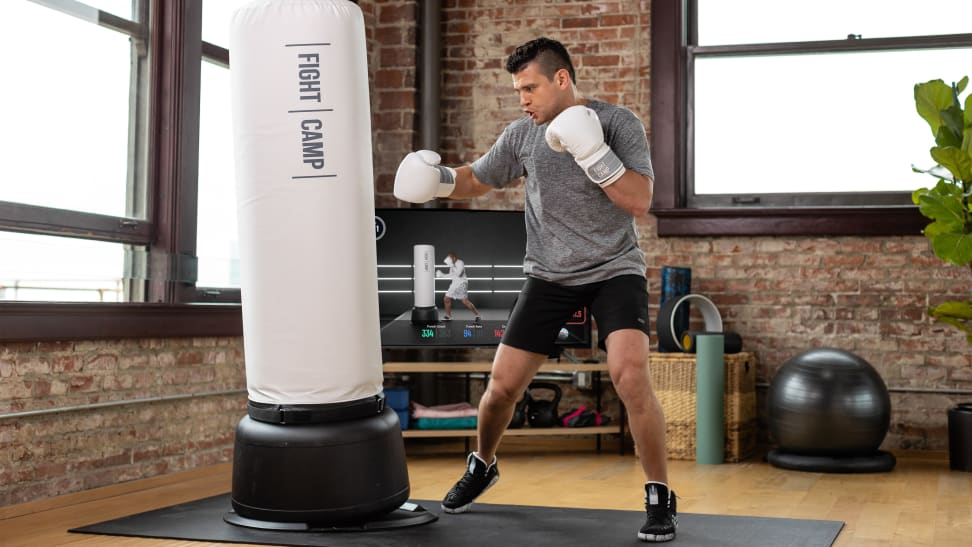 Credit:
Fight Camp
Credit:
Fight Camp
Products are chosen independently by our editors. Purchases made through our links may earn us a commission.
I’ve always wanted to try boxing, but I’m just not interested in getting punched in the face. And since undergoing knee surgery last summer, I’ve been looking for a way to build lower-body strength that keeps me out of a gym, is gentle-ish on my right meniscus, and allows me to ease into a mildly intensive distance running program. I also want to get my heart rate up.
So when I was given the opportunity to try FightCamp, an interactive at-home boxing system, I figured it could be the workout I’ve been looking for. And after using FightCamp for about two and a half weeks, I can say I don’t think I’ve ever had this much fun working out. In fact, FightCamp doesn’t even feel like work to me (until afterward, when my body informs me what I put it through). But is it worth the up-to-$1,350-plus-subscription price? Let my experience help you decide.
What is FightCamp?
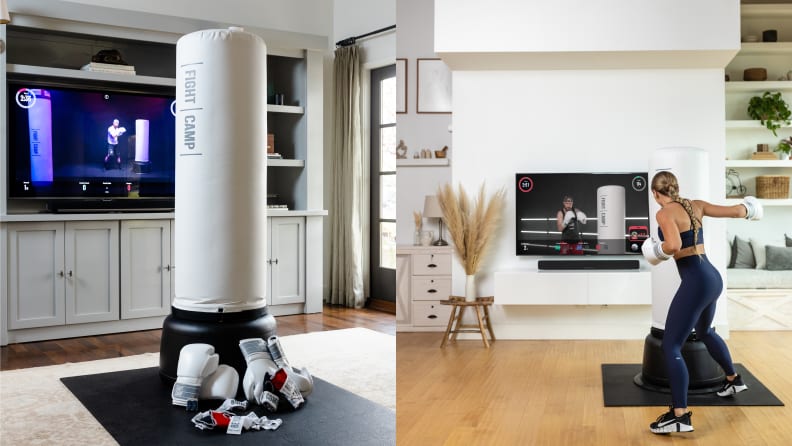
FightCamp is an interactive at-home boxing system.
Simply put, FightCamp is boxing for one. To do it, you follow along with video workouts that you stream on your own device while wearing hand wraps containing motion trackers so you can see how your jabs and crosses line up with the pros. I’ve heard FightCamp called “Peloton for boxing,” and it’s an apt comparison—you purchase the necessary equipment and pay a separate $39 monthly membership fee to access workouts on the app. The app itself is free to download, though it’s only available on iOS for now.
There are three different FightCamp packages. The barebones “FightCamp Connect” package is $439 and provides the so-called quick wraps to protect your hands and wrists, and thumb drive-sized punch trackers that count the rate and intensity of your punches; it’s presumably for someone who already owns boxing gloves and a heavy bag. “FightCamp Personal” costs $1,219 and provides a free-standing punching bag with a base (it’s about 5 feet 8 inches tall), a bag ring to keep the bag stable, a workout mat, and boxing gloves to wear over the also-included quick wraps. The “FightCamp Tribe” option has everything in the “Personal” kit and adds a second set of gloves, quick wraps, and a pair of kids’ gloves for $1,349. FightCamp sent me the “Personal” package, so that’s what this review reflects.
FightCamp provides a one-year warranty on its products and offers no-interest financing options the Personal package for $51 a month for 24 months, plus that $39 monthly fee (you can also finance the Tribe package). If you buy the equipment outright and cancel your monthly membership, the gear is still yours. Shipping is free and there’s a 30-day money back guarantee if you don’t like the product. You must have an Apple device for the app, and you can cast the videos to your TV via AirPlay or use Apple’s Lightning Digital AV Adapter and an HDMI cable. You can also stream it on an iPhone or iPad, but you'll want a tablet stand to keep it at eye level.
How to get started with FightCamp
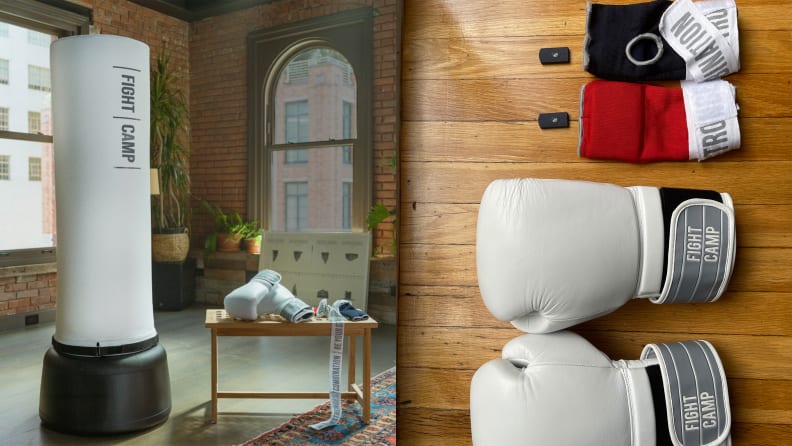
Basic FightCamp equipment includes the punching bag (left) and mini trackers, quick wraps, and boxing gloves.
My Personal package contained everything I needed to get going (minus the Apple device, which I already own, in the form of an iPhone 12). The base in which you anchor the bag was pre-filled for me with water. If you purchase FightCamp for yourself—that is, you're not reviewing it—the set-up process is more labor-intensive, and FightCamp recommends filling the base with sand, not water. (More about that below.)
I was impressed with the quality of the gloves from the outset, as they look and feel well-made—with more than 20 workouts completed, mine barely seem used—and they’re comfortable. They come in sizes small and large, and as a 6 foot tall man, FightCamp recommended I try the large. They fit my hands well, and have a wrist strap that allows them to be tightened or loosened. I found the quick wraps much easier to use than learning to do a traditional wrap—all you have to do is slide them on, insert the tracker into its internal pocket, and wrap the extra cloth around the wrist, rather than having to maneuver the wrap all around the hand. Just make sure you wash and air-dry the quick wraps at least after every other workout so they don’t stink up your home.
What it’s like to work out with FightCamp
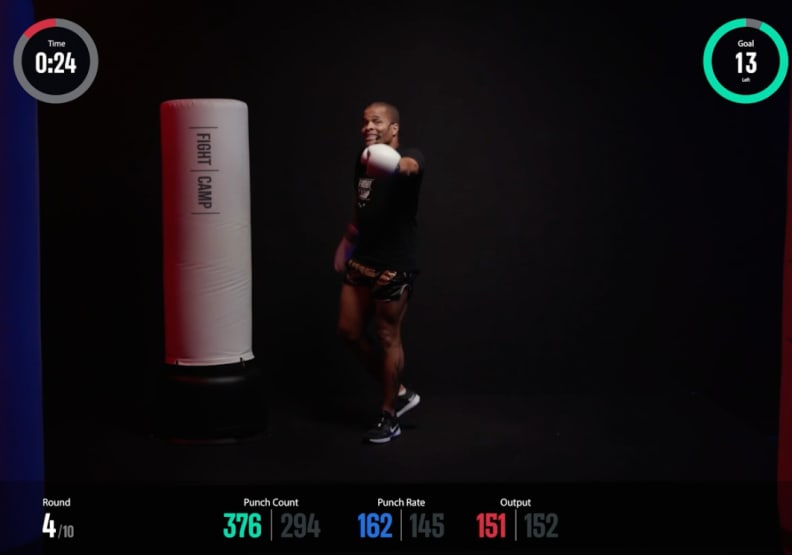
Your punches show up on FightCamp's screen.
Each FightCamp workout consists of anywhere from four to 10 four-minute rounds. A round in FightCamp includes three minutes of boxing, like in a pro fight, followed by a minute of rest. Instructors demonstrate and call out common boxing moves, such as jabs and crosses, which are labeled as “1” and “2” on screen for easy reference. If you’re right-handed, as I am, you lead with your left foot forward and jab with your left hand (it sounds counterintuitive but it makes sense once you learn it). For a rightie like me, your left hand is at face-level protecting you, your right hand is back near your right cheek.
To jab, you strike quickly by throwing your left hand straight out at your opponent—in this case, the bag—and bringing it back to your starting position. A cross is kind of like a jab with your dominant hand. For me, that means protecting my face with my left hand, striking out quickly across my body (hence “cross”) with my right, and then returning the hand to the starting position. A favorite of FightCamp instructors is to call for a 1-2 combination, which means a quick jab with your weak hand followed by a cross with your dominant hand.
There are also hooks (“3” and “4”), which, if you’ve ever seen a Rocky movie, you’ll recognize. In probably way-too-simple terms, it means you’re throwing a punch from outside in with either your nondominant hand (3) or dominant hand (4), and an uppercut (“5” and “6”) means you’re getting a little lower and punching up at your opponent’s face.
A workout is filled with on-screen information that provides feedback in real time. The coach demonstrates the workout in the center of the screen, surrounded by your workout metrics: There's a clock that counts down the remaining time in each round, a round counter showing how many rounds you’ve completed of the workout’s total, a punch count that shows how many punches you’ve thrown, a punch rate that displays how many punches you’re throwing per minute, and your total “output.” According to FightCamp’s support page, output is your total score for the workout and each round, based on the number of punches thrown, speed of each punch, and overall technique.
Those counters are FightCamp’s key attribute. Without them, aside from your general level of fatigue, there wouldn’t be a metric by which to gauge individual progress, which includes a punch goal for each round. There’s also a leaderboard you can check post-workout to see how you stack up against other users. Additionally, the app breaks down the stats listed above compared to other users, and if you’ve performed the same workout more than once, it shows how your score has changed, for better or worse, over time. I wasn’t so interested in how I compared with others, but I was glad to know how my scores improved with each workout.
Pro tip (or, in my case, barely amateur tip): Keep a clear line of sight to your screen so you can watch the trainers without craning your head if you’re unsure of the proper form or if you want to keep an eye on those punch counts. Another tip: Before beginning, make sure you’re wearing the quick wraps and that you’ve activated the punch trackers by tapping them, and slip them into their respective slots in the quick wraps (the app reminds you to link them via Bluetooth so they’re hard to forget).
Also, pay attention to how your trainer is equipped when your session begins. Are their gloves already on? Put yours on. Wraps on but no gloves? Go through the warm-up with the wraps only—the trainer gives you time to put your gloves on before the first round. You can also pause the workout and unpause when you’re ready—you’ll get a three-second count-in before your session restarts.
What we like about FightCamp
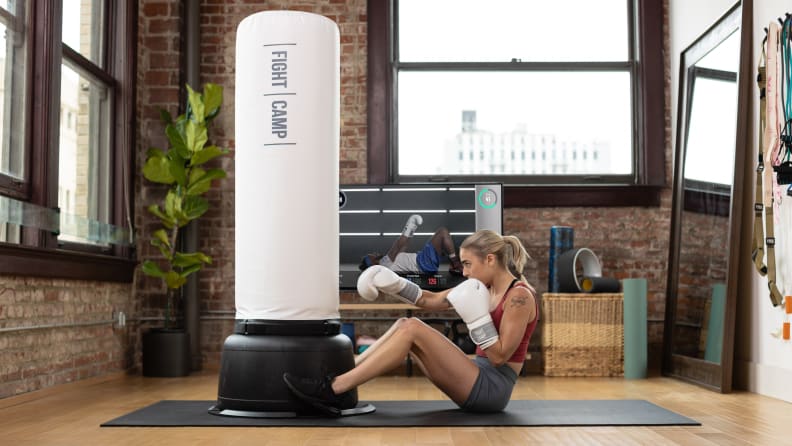
Fight Camp workouts work the core, too.
It has a huge workout selection
As of this writing, the FightCamp app contains more than 1,000 pre-recorded workouts to choose from. For beginners, there’s a useful how-to series called “The Prospect Path” in which FightCamp co-founder and former US National Boxing Team member Tommy Duquette and five other FightCamp trainers take you through the basics of boxing, from how to stand like a fighter, and how to throw different the punches. If you’d like to get into kickboxing, check out the series called “The Kickboxing Path” led by trainer Aaron Swenson with help from Duquette and trainers Shanie Smash and Flo Master.
There’s also the option to go a la carte with your sessions, which is how I proceeded most of the time. Choosing workouts is a breeze, with three featured daily workouts of four, eight, or 10 rounds. If those workouts don’t suit you, there are tons of other options with varying degrees of difficulty. (You can preview a workout by selecting it and clicking the “detail” tab.)
You can customize the workouts
As mentioned, workout length is variable from four rounds up to 10. I recommend starting small: Four four-minute rounds may not sound taxing, but as I quickly learned, a boxing workout is the definition of high-intensity interval training. Between the punching and bodyweight work, my shoulders burned and my legs were jelly at the end of a session. Each morning after using FightCamp I had that wonderful I-really-killed-it-yesterday feeling.
Another great aspect of FightCamp is you can add an optional core session after your main workout. The trainers encourage it, and the app makes it easy. After selecting the first workout, the app leads you to a subpage where you can “stack your workout” with a core session that begins when your first workout ends. Core workouts are generally 5 to 8 minutes long and, like your primary session, have different degrees of difficulty. Get ready to do planks, crunches, shoulder taps, leg raises, and more.
If you like music to go with your training, you can choose from FightCamp Radio—I usually go with House, but there are several other options including EDM, Top 40, and assorted hip-hop channels. Alternatively, you can link your Spotify, Apple Music, or Soundcloud accounts. The music levels are adjustable so you can boost the trainer and dip the tunes, or vice versa. There’s also a no-music option.
The app keeps meticulous records
As I mentioned above, the app tracks just about everything you do, showing your punch goal progress, and it records your workouts by date. It allows you to check your progress over time to see whether your punch count and intensity is increasing, or how you rate against other FightCamp members. Under your profile tab, you’ll find the “achievements” section, with categories such as “streaks,” “punches,” and “beat your score.” They’re all fairly intuitive.
No one yells at you
One unexpected and pleasant surprise about FightCamp is that each trainer is friendly and encouraging. They demonstrate lower and higher impact variations of exercises if you want to ease up or hit the gas, and there’s no shouting, berating, or intimidation, at least in the workouts I did. That may sound like a no-brainer for a program that requires a significant financial investment and an additional $39 a month. But as someone who’s been shouted at in Little League, swim team, on the rugby pitch, and on the golf course, about the last thing I want to experience in my workouts is anything resembling negativity.
What we don't like about FightCamp
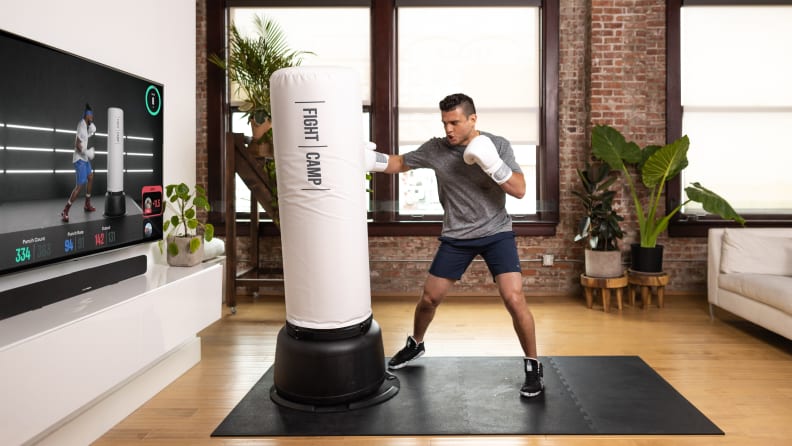
As fun as FightCamp is, it requires a lot of space.
Setting it up isn’t quick and easy
If you can get past the device’s expense, the first obstacle is its setup. The FightCamp base that anchors the bag needs to be filled with something so it doesn’t slide all over your floor. FightCamp recommends filling the base with 350 pounds of dry sand (you read that correctly). FightCamp has an instructional video on YouTube featuring two trainers demonstrating the process. They make it seem simple, but getting that much sand into your home is likely less than optimal, especially if you live in an apartment in a large city, like I do, as opposed to a standalone house.
Alternately, you can fill the base with about 250 pounds of water, or about 30 gallons—that’s how mine arrived. That may be easier than the sand option, assuming you have nearby access to a spigot and a hose, but with that relatively reduced weight as an anchor, I find I sometimes can push the bag off the end of the floor mat during particularly energetic workouts. Returning the bag to its starting position requires knowing how to move 250 pounds without throwing out your back, and though I can do it, it’s not how I want to begin a training session.
You’ll need space, and plenty of it
FightCamp suggests laying out the eight workout mats provided in four rows of two across. (You may not need the mats, but I found them useful, especially during core workouts.) If you do this, you’ve committed almost 8 feet by 4 feet of floorspace for working out and because the contraption weighs at least 250 pounds, you’re probably not going to be keen on moving it into the corner after each use. In other words, that real estate on your floor now belongs to FightCamp.
And remember, the bag ring, base, and bag itself measure about 5 feet 8 inches, or approximately one Zac Efron. Stick it near a window and you’ll lose some sun and some views, and if you position it near your TV, your watching area for when you're not doing FightCamp.
The app is currently only available on iOS
FightCamp tells us that an Android app is in the works, but offered no set date for its availability. That means a lot of people can’t use it, which we think is a bummer.
Should you buy FightCamp?
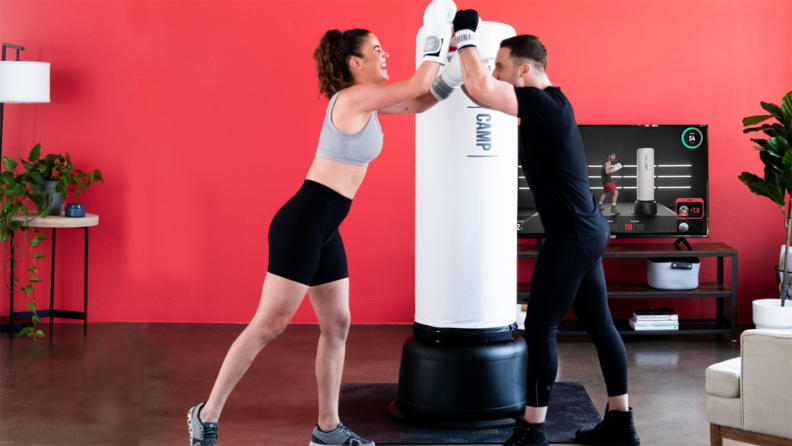
FightCamp is a lot of fun for the right person.
If you’re not sure about whether to invest the money or space in FightCamp, proceed with caution. Check out the FightCamp blog and the YouTube channel for additional information. You can also search its workout library online to see if anything there appeals to you.
What I can say is that FightCamp is a serious program that rewards the effort you put into it. After 20ish workouts, I can already see some more definition in my arms. I’ve never noticed quick results like that, though I also switched to a much healthier diet when I started testing FightCamp, so maybe factor that in.
I don’t miss the gym, and FightCamp wears me out. When I want to do a more strenuous lower-body workout, I supplement FightCamp with weights I have at home. Overall, FightCamp offers an excellent workout, it’s fun, and I get to throw punches without worrying I’ll take a hook to the jaw. And by those standards, I can’t recommend it enough.


